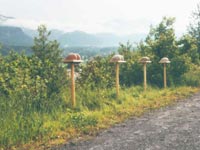
Arbeit am Lehm-Modell | Werkstatt Kosma | Klosterneuburg | Sommer 2001
Lecksteine
Viehsalz (Salz, Spurenelemente), Lebensmittelfarbe; gegossen
Diese Lecksteine habe ich für die „Sollbruchstellen - künstlerische Interventionen einer Erdbeben-Linie quer durch Kärnten entlang“ entwickelt.
„Die Formensprache der Objekte wurzelt in der Gespaltenheit der Kärntner Seele, und fügt sich subtil in die Kärntner Naturlandschaft ein. Auch das verwendete Material ist der Tradition verbunden: Lecksalz, wie es seit alters her Vieh und Wild zur Labung dient. In eine neue Form gegossen, dient es Mensch und Tier: zum Anschauen und Angreifen, zum Schmecken und Riechen. Ein reines Naturprodukt.“
Gerhard Pilgram
Der Bildhauer Thomas Kosma war mir bei den Lehm-Modellen behilflich und hat die Gussformen der Lecksteine erzeugt; von ihm kam auch die Idee, die Lecksteine zum Teil mit Lebensmittelfarbe (braun, rot und gelb) einzufärben.
Salt blocks
Cattle salt (salt, trace elements), food colouring; cast
I developed these salt-lick blocks for the project „ rated breaking points - artistic interventions along a fault line through Carinthia“.
„The formal language of these objects is rooted in the split nature of the Carinthian soul, and subtly blends into the natural landscape of Carinthia. The material employed is also connected to traditions: salt licks, as they have been used for the nourishment of domesticated and wild animals since ancient times. Cast into a new mould, it serves animals and humans: to be looked at and touched, tasted and smelled. A purely natural product.“
Gerhard Pilgram
The sculptor Thomas Kosma helped me with the clay models, and produced the moulds for the salt-lick blocks; it was also his idea to dye some of the blocks with food colouring (brown, red, and yellow).
© Uwe Bressnik
letzte Aktualisierung: 16.07.2018

 Silikon-Form
Silikon-Form Galerie Bäckerstrasse Wien | 2008
Galerie Bäckerstrasse Wien | 2008 Galerie Bäckerstrasse Wien | 2008
Galerie Bäckerstrasse Wien | 2008 Kasseler Kunstverein | 2012
Kasseler Kunstverein | 2012 Kasseler Kunstverein | 2012
Kasseler Kunstverein | 2012 zurück /
zurück /